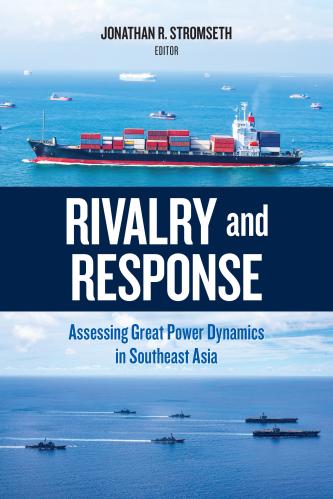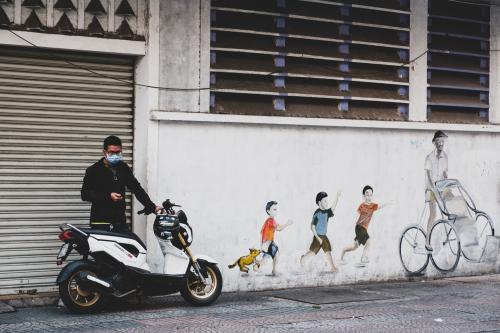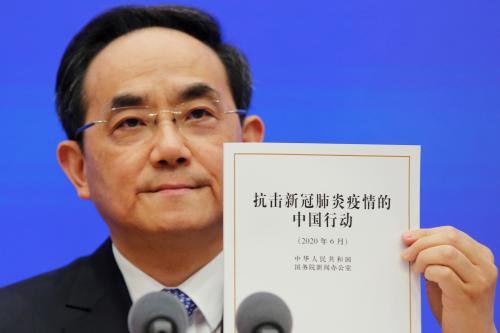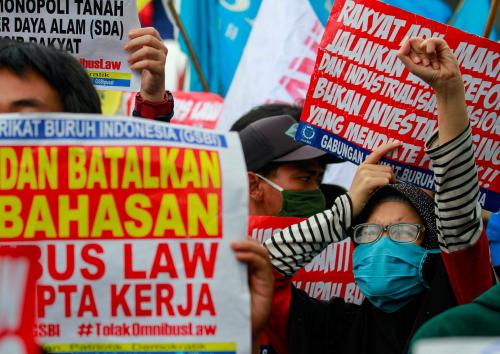The COVID-19 pandemic brings to light the essential role of politics in shaping public health around the world. Some advanced democracies such as the United States have experienced bitter partisan conflict over the public health response, and in many fragile democracies, populist leaders have downplayed the threat of the virus. At the same time, some democratic governments — from Australia to South Korea — have acted quickly and assertively to combat the pandemic through aggressive testing and contact tracing programs, as well as strict lockdown measures.
Although most of the scholarly and academic commentary on the politics of the COVID-19 response has focused on the advanced industrial democracies, there are important lessons to be drawn from the experiences of Southeast Asia. The figure below charts the cumulative number of COVID-19 deaths per 1,000 residents for each of the 11 Southeast Asian countries.
As the data show, some of the world’s most successful governments in combatting COVID-19 are in this region — Vietnam and Singapore, in particular. It also contains some notable laggards, such as the Philippines and Indonesia.
How can we make sense of the politics of Southeast Asia’s COVID-19 experience? And what lessons does this experience hold for the rest of the world? A comparative examination of the Southeast Asian record suggests that party-state linkages are one important factor that explains why some countries were able to manage the COVID-19 pandemic effectively, whereas others were not. The state is certainly not the only factor that matters for understanding why the impact of COVID-19 has been so varied — pandemic management is inherently a complex, multi-level governance challenge — but a focus on the state provides useful analytical leverage for making sense of the Southeast Asian experience.
First, some terminological clarity is necessary. By the state, I mean the political organization with the monopoly on the use of legitimate violence within a given territory. This is Max Weber’s definition of the state. We can distinguish states from political regimes, which are the institutions that allocate political authority within a state, and also from governments, which are the teams of individuals who wield political authority under a particular political regime.
The state is a tricky concept because it is so abstract. Still, for decades, scholars working across the social sciences have invoked the state to understand factors from capitalist development to taxation to repression. Most notably for scholars of Southeast Asia, scholars working on comparative economic growth have focused on the concept of the developmental state as explaining the success of Singapore relative to other capitalist regimes such as Malaysia and Thailand. The state has also played an important role in our understanding of the military and the bureaucracy in countries like Indonesia and Myanmar.
But how to put the state to work analytically to understand the various experiences of Southeast Asia in managing COVID-19? The strongest states have the ability to work with their citizens to accomplish complex governance tasks, as well as the ability to compel their citizens to comply with policy directives — even unpopular ones. Michael Mann called the first of these abilities infrastructural power and the second despotic power.
But not all states possess infrastructural and despotic power in equal measures. To see why, we can focus on two ways in which states vary. First, states vary in their objective physical conditions. Some states cover small and geographically compact territories (Singapore, Brunei). Others cover large and geographically dispersed territories (Indonesia, the Philippines). All else equal, it is easier to deliver services and enforce costly and perhaps unpopular policies in small territories, especially those without distant peripheries that are difficult to administer. A compact geography facilitates despotic power.
Second, and turning to focus squarely on politics, states vary in their relationship to ruling parties. Although states and political parties are conceptually distinct, in some countries the institutional structure of the ruling party is basically coterminous with the state’s administrative and repressive apparatus. In other countries, the two are only loosely related, if at all.
Examples of tight party-state linkages include the Southeast Asian countries like Vietnam and Singapore. In these two cases especially, members of the ruling party occupy nearly every important position in the bureaucracy, and there are few sources of administrative autonomy. This fusion of the party and the state matters for pandemic management because it gives the ruling party all of the administrative and repressive tools that it needs to implement policies to contain COVID-19, even unpopular and economically disruptive ones. These linkages align the ruling party’s incentives for pandemic management with those of state officials. Tight state-party linkages, for this reason, facilitate infrastructural power.
This fusion of the party and the state matters for pandemic management because it gives the ruling party all of the administrative and repressive tools that it needs to implement policies to contain COVID-19.
Examples of loose party-state linkages include countries like Indonesia and the Philippines. Indeed, a firm distinction between the ruling party and state is a characteristic found in perhaps all electoral democracies. In these cases, ruling parties and elected administrations must work with the state’s administrative and coercive apparatus to implement policies. Party elites and elected officials are not part of the same institutional hierarchy as are police and public health authorities. They may have different incentives, and aside from high-level political appointees, party membership plays little substantive role in career advancement. This division between the state and the ruling party is beneficial for ensuring that ruling parties do not become too powerful; but it does undermine their ability to respond quickly and effectively to an acute crisis such as a pandemic.
We can also speak of party-state linkages in countries where partisan competition is highly circumscribed, as in Thailand, or even absent, as in Brunei. Here, the analogue of the ruling party is the ruling junta and the palace. In Thailand, but especially in Brunei, these are tightly linked to the administrative and coercive apparatus of the state itself.
In sum, we can distinguish Southeast Asian countries according to their geographic endowments and party-state linkages. The state in geographically compact Singapore, which has been deeply tied to the ruling People’s Action Party since independence, was well-positioned to respond effectively to the pandemic. Vietnam’s geography is rather less easy to work with than Singapore’s, but the very close relationship between the party and the state gives it substantial infrastructural power. The Indonesian state — a sprawling and politically decentralized archipelago — was ill-positioned to respond to COVID-19. Other states lie between these two extremes.
My emphasis on the state does not imply that government policies and leader choices are immaterial. President Rodrigo Duterte in the Philippines did not downplay the COVID-19 threat because he lacked an effective and capacious state. Nor did President Joko Widodo in Indonesia vacillate and delay his COVID-19 response because of his state’s geographical complexity and his party’s relative weakness. Nor does an emphasis on the state deny the importance of factors like preexisting health infrastructure, which in the notable case of Thailand has made pandemic management far easier than it might otherwise have been.
But one benefit of a focus on the state is that it helps to situate the successful Southeast Asian cases relative to other successes in the region and beyond. Vietnam and Singapore — like South Korea and Taiwan, as well as Rwanda and New Zealand — monitor health conditions, aggressively sanction their citizens for noncompliance, and coordinate policy delivery across jurisdictions and administrative bodies. But South Korea, Taiwan, and New Zealand do not quite match the strong party-state linkage that characterize Singapore, Vietnam, and Rwanda. It may be that in countries like South Korea, a professional and autonomous bureaucracy provides an alternative to the strong party-state linkages that we see in the successful Southeast Asian cases. Although the specific details may differ outside of Southeast Asia, all of this reinforces the general point that a focus on the state yields useful analytical leverage over the politics of COVID-19.






Commentary
What state-party relations mean for COVID-19 management in Southeast Asia
January 7, 2021